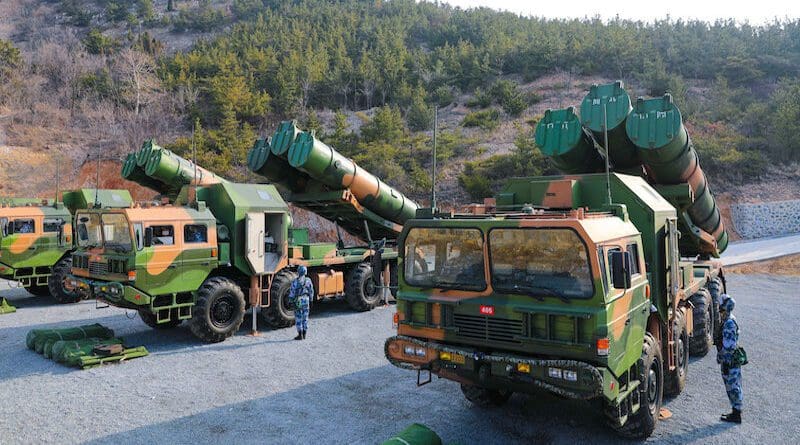Nicholas R. Licata

In an effort to transform the People’s Liberation Army (PLA) into the most technologically advanced military in the world, the Chinese Communist Party (CCP) is systematically reorganizing its science and technology sectors to ensure that new innovations simultaneously advance the growth of its military capabilities.
This “Military-Civil Fusion” (MCF, 军民融合) strategy targets technologies such as quantum computing, semiconductors, 5G, nuclear technology, aerospace technology, gene editing and artificial intelligence to achieve military dominance. While other nations have tried this strategy before, China’s MCF is expansive and institutionalized in a way that exceeds previous efforts. China is likely to produce a variety of new weapons of mass destruction using this policy in the next decade and threaten the United States’ regional interests more than it already has. MCF is still in its early stages but if the United States does not catch up with China’s strategy soon, it risks being technologically outpaced.
MCF applications in China date back to the 1980s and 1990s, but the concept of MCF as a core national policy is a relatively new phenomena under the Xi presidency, tailored to a globalized commercial ecosystem. In pursuing MCF, the CCP has gone as far as to establish the Central Commission for Integrated Military and Civilian Development in 2017 to oversee its integration, and shows little signs of slowing down. Recent documents and initiatives such as the 13th Five-Year Plan and 19th National Congress of the CCP describe a MCF framework that is early in its actualization, but capable of posing significant security challenges for the United States and its Indo-Pacific allies.
Despite how recently China enshrined MCF in its national agenda, the United States already recognizes it as a major concern for its interests in the Indo-Pacific. While China has been seeking avenues to potentially develop key technologies via MCF, the United States has been vocal in accusing China of corporate espionage and undermining American companies. Among the sectors targeted by MCF, artificial intelligence (AI), nuclear energy, and gene editing are at particular risk of these practices, and have the most substantial implications for PLA strategic dominance over the United States.
Left unchecked, these could lead to the manufacture of weapons that shift how wars operate in the future. AI may lead to advances in defense equipment such as missiles, command decision making, and military simulation. Nuclear energy can be repurposed to increase the number of nuclear warheads China already has or improve the destructive potential of its arsenal. Strides in gene editing such as CRISPR-Cas9 could result in genetic weapons of mass destruction. Considering the existential threats MCF poses for its security, the United States must respond quickly before it is surpassed by China’s military.
Due to the dual-use nature of these technologies, they offer civilian applications in addition to military uses. This presents a major dilemma for the United States in navigating MCF: While these technologies may lead to the development of highly dangerous weapons and technologies, they are each a part of sectors which are already deeply integrated into US-China trade. Any move it makes to restrict Chinese gains in these industries risks significant economic blowback via trade restrictions, boycott campaigns, unilateral sanctions or other coercive means. In its strategy to counter MCF, the United States is responsible for drawing the line on Chinese technological advancements in a way that does not sacrifice its industries and risk handing leverage to China.
Thus far, the United States has implemented policies which restrict the flow of information China uses to bolster the PLA, such as visa limits for exchange students and restrictions on the sale of goods necessary to create technologies targeted by MCF. While these measures impede the rate at which China can gain technologies critical to improving its military technology, they incur staggering consequences for the United States’ technological innovation and corporations.
For example, the United States recently faced backlash due to additional limits it plans to impose on the sale by American firms of advanced semiconductors in order to curtail China’s progress on AI. Some American chip makers such as Nvidia, Intel, and AMD earn as much as a third of their revenue from Chinese buyers. By halting shipments of these chips, the United States risks gutting the industry overnight and accelerating China’s development of an independent chip industry. It runs similar risks in other sectors targeted under MCF, which are similarly integrated into each other’s economies.
The United States should continue to identify specific MCF sectors which have the most potential to influence Chinese state behavior and lead to creation of highly dangerous weapons, but not impose measures which explicitly discriminate against Chinese corporate interests and accelerate Chinese industrial independence. Instead, Washington should endeavor to strengthen its own technological base in these industries, and collaborate with other actors to establish international guidelines and regulations which prevent China from acquiring the most destructive forms of these technologies.
By gradually reorganizing its supply chains in MCF-targeted industries, the United States can de-risk its trade with China and protect technological innovation without having to fully decouple and cause the CCP to ramp up its industrial independence. As for international frameworks, the United States should consider propositions which aim to regulate, not prevent the production of these technologies. For example, the International Committee of the Red Cross’s “position on autonomous weapon systems” allows the production of AI-based weapons systems while establishing critical humanitarian guidelines to prevent misuse. By doing this, the United States could limit China’s acquisition of advanced weapons of mass destruction without directly threatening it.
The United States cannot prevent China from harnessing emerging industries to boost its military might, but it can minimize the possibility for the PLA to overshadow the US military. The sooner it adjusts its response to MCF to bolster its own industries and help establish international guidelines for MCF-targeted technologies without directly provoking the CCP, the sooner it will be able to mitigate any possibility of Chinese military superiority.
No comments:
Post a Comment